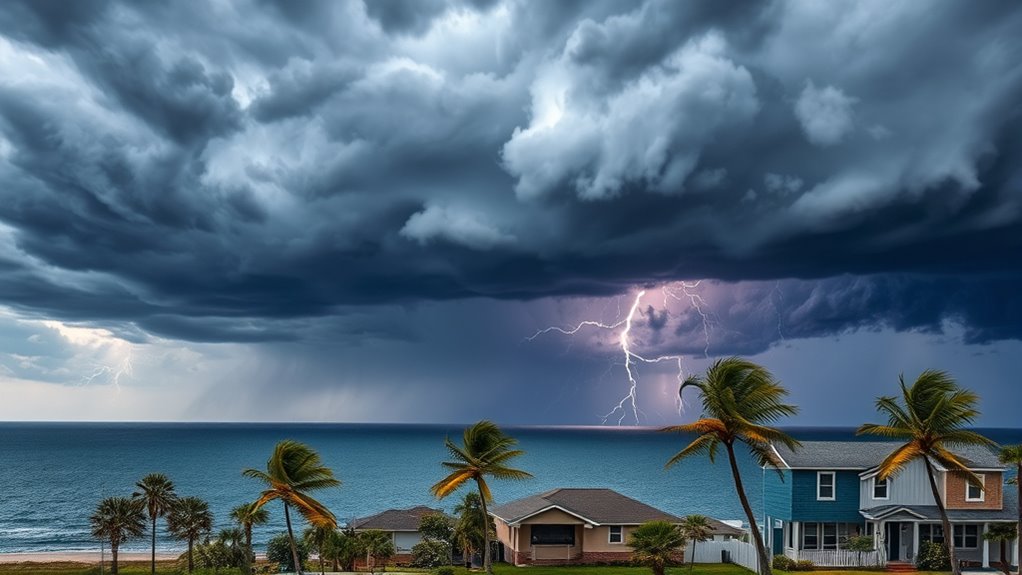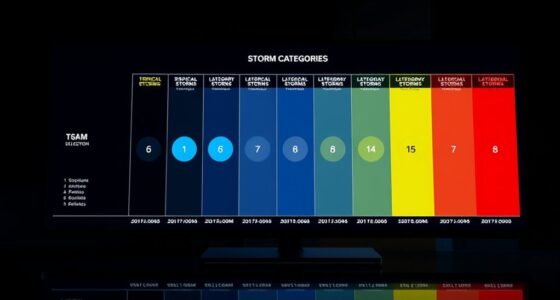The 2025 Atlantic hurricane season is forecasted to be highly active, with climate change fueling stronger storms, longer seasons, and increased risks for coastal areas. To prepare, stock emergency supplies, secure your property, and develop a family evacuation plan. Stay informed through official forecasts and weather updates, as evolving storm patterns demand ongoing vigilance. If you want tips to stay safe and protect your home, there’s more you should know.
Key Takeaways
- The 2025 Atlantic hurricane season is predicted to be active with above-average storm activity.
- Climate change is extending storm seasons and increasing hurricane strength, requiring heightened preparedness.
- Develop an emergency plan, secure property, and store supplies early before peak season.
- Monitor official forecasts from the National Hurricane Center regularly for the latest updates.
- Familiarize yourself with evacuation routes, shelters, and ensure insurance policies cover hurricane damages.

The 2025 Atlantic hurricane season is shaping up to be an active one, with meteorologists predicting above-average activity based on current climate patterns. This forecast isn’t surprising, considering how climate change impacts are altering storm behavior and intensity. Rising sea surface temperatures provide more energy for storms to develop and strengthen, making hurricanes potentially more powerful than in previous years. Historically, storm patterns have also shifted, with some regions experiencing increased frequency and intensity of hurricanes over recent decades. These changes underscore the importance of staying informed and prepared as the season approaches.
Understanding the influence of climate change impacts on hurricanes helps you grasp why this season might be more intense. As global temperatures continue to rise, the Atlantic Ocean heats up more quickly, fueling storms with additional energy. This means you could face stronger winds, heavier rainfall, and more damaging storm surges. Furthermore, climate change is contributing to longer storm seasons, giving hurricanes more time to develop and cause destruction. Recognizing these evolving patterns can help you better anticipate risks and make smarter preparations for your home and family.
Historically, storm patterns in the Atlantic have varied, but recent trends highlight increased activity during certain months. The season typically peaks between August and October, but climate change can extend this window, making earlier or later storms more likely. Being aware of these historical trends enables you to plan ahead, especially if you live in vulnerable coastal areas. You should stay updated with official forecasts from the National Hurricane Center and local authorities, as they incorporate the latest climate data and storm models to provide accurate predictions.
Historically, Atlantic storms peak August to October, but climate change may extend this window, increasing early or late season storms.
Preparation begins with understanding that the climate change impacts on storm behavior mean you need to act proactively. Stock up on emergency supplies, secure your property, and develop a communication plan with your family. Keep important documents in a safe, waterproof location, and ensure your insurance policies cover hurricane-related damages. Also, familiarize yourself with evacuation routes and local shelters. As storm patterns evolve, so should your readiness strategies. Climate change impacts and the shifting storm patterns highlight the need for ongoing vigilance. The key is to stay informed, monitor weather updates regularly, and heed official warnings promptly. By understanding the shifting climate impacts and historical storm patterns, you’ll be better positioned to protect yourself and minimize damage during this active hurricane season.
Frequently Asked Questions
How Can I Track Hurricanes in Real-Time?
You can track hurricanes in real-time by using storm tracking tools like NOAA’s website or the Weather Channel app. These platforms provide up-to-date satellite imagery, showing you the storm’s location and movement. Additionally, you can follow official updates from meteorological agencies on social media. By monitoring these sources regularly, you stay informed about storm developments and can act quickly if a hurricane approaches your area.
What Are the Early Warning Signs of Hurricanes?
You’ll notice early warning signs of hurricanes like increasing wind speeds, darkening skies, and a rising storm surge along the coast. Watch for sustained strong winds that can cause damage and dangerous storm surge levels that threaten low-lying areas. Stay alert to weather updates, because these signs often indicate an approaching storm with potential wind damage. Acting quickly can help you prepare and stay safe during this threatening weather.
Which Areas Are Most at Risk This Season?
You’re in the eye of the storm’s fury, with coastal areas most at risk this season. Expect monstrous storm surges that can swallow entire neighborhoods, forcing quick evacuations. If you’re near evacuation zones, stay alert and ready to move at a moment’s notice. These zones are your lifeline, designed to keep you safe from the rising waters and fierce winds that threaten to turn your world upside down.
How Do Hurricane Forecasts Improve Over Time?
Hurricane forecasts improve over time thanks to technological advancements and better predictive modeling. These innovations allow meteorologists to analyze satellite data, ocean temperatures, and atmospheric conditions more accurately. As technology advances, forecasts become more precise, giving you earlier warnings and better preparation time. This ongoing progress helps communities stay safer, enabling timely evacuations and resource planning, ultimately reducing the impact of hurricanes on lives and property.
What Are the Long-Term Impacts of Hurricanes on Communities?
You might think hurricanes only cause immediate damage, but their long-term impacts are profound, especially with climate change intensifying storms. Communities face prolonged recovery, economic setbacks, and mental health struggles. Building resilience helps you adapt and bounce back faster. By investing in sustainable infrastructure and emergency planning, you strengthen your community’s ability to withstand future hurricanes, ensuring long-term safety and stability despite changing climate conditions.
Conclusion
As you prepare for the 2025 Atlantic hurricane season, stay vigilant and keep your emergency kit ready—because, in the end, you’re the hero of your own story. Remember, even with all the tech and forecasts, Mother Nature can surprise us. So, stay informed, follow local advice, and don’t wait until the last minute. After all, it’s better to be safe than to find yourself caught in a real-life disaster like the Titanic.









